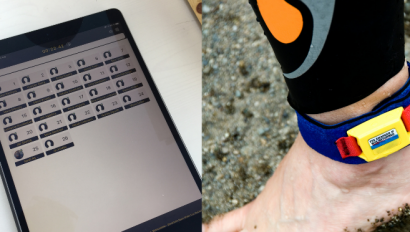How Much Does it Cost to Organize a Race?

Article updated 1 August 2024.
Perhaps you are thinking of starting your own race, and wondering what it will cost to do so. The answer can be varied, because it depends on many factors – how big your event is, what you want to offer participants, if you plan to offset costs to sponsors and more. In this article, we help you with a breakdown of costs that can be involved when you organize any type of race in any sport, starting with required or essential costs and followed by optional items.
Here is also a handy budgeting template, you may download so you can play around with your numbers (for first time race organizers or established ones that want to rethink their set up):
Essential costs for Organizing an Endurance Race
Timekeeping
The definition of a race is to compete and select a winner. For 90% of events, this means keeping track and recording the finish time for your racers. Perhaps your event is more of a joint experience and adventure, and then you may skip this part. But if you call it a race, participants usually expect to get a result. Here are some options for timekeeping, in order of price low to high:
Old School Stopwatch: this is the most simple way you can record times at your race. Buy a stopwatch (at any sports department store or amazon). Use it to start the race, and press the button for every finisher at the finish line. You may want to start 2 stop watches at the start, so you have a backup in case you mistakenly stop the first one. Anyhow, stopwatch timing is very risky as you easily get confused and push the wrong buttons and there is no “control+z” or back button you can fix that with. It is also very stressful and you cannot handle many participants at once. You would also have to manually write down times in either your computer or on a piece of paper, and then make a result list yourself. The stopwatch method is prone to plenty of human error, but can be a good option if you are only doing a small text race of 20-30 people as it is very cheap.
Price: 10-20 EUR
Use a Timing App: There are a few timing applications on the market now that have taken the stopwatch method but digitalized it into an application that is easier to maneuver (Check out the RaceID Timing App!). How this works is that you upload your start list (if using RaceID Timing, you’ll have all your registered races in the app automatically as the system is connected to the registration and start list) into the timing app and start the race. The race rolls along in the app, and the only thing you have to do is to click on each racer as they cross the finish line- The result and time is recorded automatically. When you finish the race, you have a result list generated without having to do anything.
You can prepare beforehand, and place checkpoints along the course for taking split times. You can also allow assistant timers to work on the race with you, through individual and limited-access accounts. Read more about the RaceID Timing App here. Timing apps are a great option for slightly smaller races, and are usually cheap in comparison to other more high-level timing methods. However, this method is not recommended for races with several thousand participants as you will not be able to catch them all at the finish line.
Price: Usually around 1 EUR per racer (example, race for 200 people: 200 EUR)
Chip or rfid Timing: for this method, you usually hire a provider that handles the entire timekeeping operation for you. With chip timing, the provider sets up portals for the start and finish (and any split times you need), and provides chips to each racer. These chips fire when the racers pass the portals, and automatically registers the time and results in a live result list – usually published online for spectators to follow.
This timing method is great and almost required for large races of several thousand people. It is usually reliable and requires little to no effort from you as a race director if you rent the service. On the cons side, this method is expensive as it involves hiring a timing expert for the day as well as the hardware required.
Price: 2000 EUR to 10 000 EUR (depending on the size of the race)
Equipment for marking the course
A post that is very important, is to mark the course properly so racers know where to go. You can do this with ropes, flags, spray paint or signs. Count around 100-200 EUR at least, depending on how long your course is.
Start bibs & start numbers
Your racers usually need a sign with their start number on it to be identified. If you are using chip timing, they are sometimes included as the chip can be integrated into the back of the sign. If not, count on paying around 2 EUR per participant for starting bibs or number plates.
Food & Energy for your racers
Perhaps this part is not always essential – but as an athlete writing this post, I decided to include it! As a racer, you usually expect to get at least some water or sports drinks along the course, and usually also some sort of energy.
Calculate to spend a few cents per racer on food and energy, as well as a budget for cups or ways to serve the food on the course.
Offering racers food after the race is also popular and you can do this by inviting vendors to your arena also to save on costs. You can also find nutrition sponsors that may want to provide their products for free as part of a marketing campaign.
Marketing for your race
If you have no racers, you have no race. You will need to spend some money (or at least time and energy) to market your race. Get ideas and a complete marketing plan for your race in this post.
Price: 100-5000 EUR
Registration Software & Online Payments
You will need a way for participants to register and pay for your race. In today’s highly digitalized world, most racers expect to sign up and pay online. This also ensures you that each racer has paid before they even enter the start list. There are several vendors to choose from – and the processing costs that Visa and Mastercard or any payment provider requires, is usually part of the fee for using such a platform. Make sure that your registration provider is purpose-built for handling outdoor events and racers. It makes it much easier as you can get automatic start lists, compared to using a general sign-up service such as eventbrite or similar tools. Check out RaceID Registration features for more info.
Price: usually around 5-10% of your registration fee per racer.
A budget alternative to race registration tools is to simply use email or a Google Form where participants can register. However, you then have to make sure you collect payments on the side by bank transfer to your account, and it can be a hassle to pair payments with who is in the start list and to chase those that do not pay….
Arena Set-up costs
You will need to create some sort of race arena to mark the home of your race and provide a place for racers and spectators to hang out. This can cost a bit of money as you may have to rent chars, tables and tents etc. You can also keep this cost low, by borrowing or bringing chairs from your house or neighbors if you organize a smaller event. You may also have to pay for a lease or rental of your arena space.
Price: 100- 5000 EUR
Optional Costs for an Outdoor Event
Printed material and branding for the arena
If you are serious about your event, print your logo and on some nice flags to put up around your race arena. This can cost a bit of money, but it makes a big difference to the race ambiance!
Price: 100-2000 EUR (depending on the type of material you need, usually a printed flag costs 50-100 EUR)
Merchandise, prizes & finisher t-shirts
A very nice detail is for your racers to receive a branded t-shirt or other item as a reminder of the race. This also benefits you for future marketing purposes, as you will have commercials for your race wandering around as your racers use the shirts or merchandise in their training or leisure. Make sure you also have some great prizes for the top-3 results in the race – prize money can help you attract the elite.
Price: 10-30 EUR per t-shirt
Staff & Volunteers
If your race is larger than 100 people, it gets hard to do everything yourself. You will need to either recruit volunteers that work for you for free or to hire a team to help you. This can greatly vary, so you will need to check going rates for hourly wages in your area.
You should also review the type of personnel and equipment needed for safety reasons – make a Risk Assessment of your race and see what you need to spend money on (maybe doctors and emergency personnel are needed on-site for example!).
How to make a budget for an endurance race
Now that you have an idea for the different parts in your budget, it is time to estimate the costs and put together an initial calculation for your business case. Use the budget template and add your expected costs presented above. You can play around with the number of participants you need to break even, and compare it to different registration fees to see how you would do. In the template, you just enter different numbers for those cells, and the total sums will update. Make sure you will not make a loss, and put some margin on your registration fee – it is always good to have some buffer for unexpected events!
A good way to get a bit more income or get help with costs, is to get sponsors for your race. Sponsors can either help you by giving cash in exchange for their brand to be featured in association with your event in different ways, or provide material that has their branding (like flags or starting portals for example).
Best of luck, and let us know if you want to chat about your race set up. We are a team of athletes and ex-race directors, so we are always happy to talk about races with you! Book a meeting or get started now.


